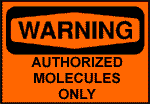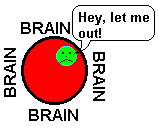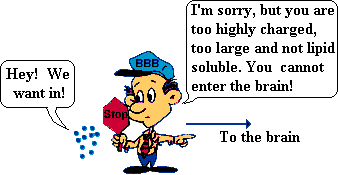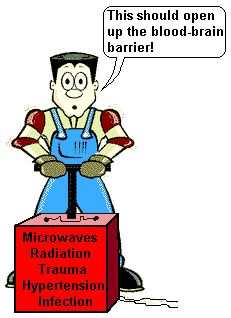Neuroscience For Kids
The Blood Brain Barrier ("Keep Out")
 More than 100 years ago it was discovered that if blue dye was injected
into the bloodstream of an animal, that tissues of the whole body EXCEPT
the brain and spinal cord would turn blue. To explain this, scientists
thought that a "Blood-Brain-Barrier" (BBB) which prevents materials from
the blood from entering the brain existed. More recently, scientists have
discovered much more about the structure and function of the
BBB.
More than 100 years ago it was discovered that if blue dye was injected
into the bloodstream of an animal, that tissues of the whole body EXCEPT
the brain and spinal cord would turn blue. To explain this, scientists
thought that a "Blood-Brain-Barrier" (BBB) which prevents materials from
the blood from entering the brain existed. More recently, scientists have
discovered much more about the structure and function of the
BBB.
Anatomy of the BBB
 The BBB is semi-permeable; that is, it allows some materials to cross, but
prevents others from crossing. In most parts of the body, the smallest
blood vessels, called capillaries, are lined with endothelial cells.
Endothelial tissue has small spaces between each individual cell so
substances can move readily between the inside and the outside of the
vessel. However, in the brain, the endothelial cells fit tightly together
and substances cannot pass out of the bloodstream. (Some molecules, such
as glucose, are transported out of the blood by special methods.)
The BBB is semi-permeable; that is, it allows some materials to cross, but
prevents others from crossing. In most parts of the body, the smallest
blood vessels, called capillaries, are lined with endothelial cells.
Endothelial tissue has small spaces between each individual cell so
substances can move readily between the inside and the outside of the
vessel. However, in the brain, the endothelial cells fit tightly together
and substances cannot pass out of the bloodstream. (Some molecules, such
as glucose, are transported out of the blood by special methods.)
 Glial cells (astrocytes) form a layer around brain blood vessels and
may be important in the development of the BBB. Astrocytes may be also be
responsible for transporting ions from the brain to the blood.
Glial cells (astrocytes) form a layer around brain blood vessels and
may be important in the development of the BBB. Astrocytes may be also be
responsible for transporting ions from the brain to the blood.
Functions of the BBB
The BBB has several important functions:
- Protects the brain from "foreign substances" in the blood that may injure the brain.
- Protects the brain from hormones and neurotransmitters in the rest of the body.
- Maintains a constant environment for the brain.

General Properties of the BBB
- Large molecules do not pass through the BBB easily.
- Low lipid (fat) soluble molecules do not penetrate into the brain. However, lipid soluble molecules, such as barbituate drugs, rapidly cross through into the brain.
- Molecules that have a high electrical charge are slowed.

The BBB can be broken down by:
- Hypertension (high blood pressure): high blood pressure opens the BBB.
- Development: the BBB is present, but may be not fully formed at birth.
- Hyperosmolitity: a high concentration of a substance in the blood can open the BBB.
- Microwaves: exposure to microwaves can open the BBB.
- Radiation: exposure to radiation can open the BBB.
- Infection: exposure to infectious agents can open the BBB.
- Trauma, Ischemia, Inflammation, Pressure: injury to the brain can open the BBB.
Circumventricular Organs
There are several areas of the brain where the BBB is weak. This allows substances to cross into the brain somewhat freely. These areas are known as "circumventricular organs". Through the circumventricular organs the brain is able to monitor the makeup of the blood. The circumventricular organs include:
- Pineal body: Secretes melatonin and neuroactive peptides. Associated with circadian rhythms.
- Neurohypophysis (posterior pituitary): Releases neurohormones like oxytocin and vasopressin into the blood.
- Area postrema: "Vomiting center": when a toxic substance enters the bloodstream it will get to the area postrema and may cause the animal to throw up. In this way, the animal protects itself by eliminating the toxic substance from its stomach before more harm can be done.
- Subfornical organ: Important for the regulation of body fluids.
- Vascular organ of the lamina terminalis: A chemosensory area that detects peptides and other molecules.
- Median eminence: Regulates anterior pituitary through release of neurohormones.
Copyright © 1996-2017, Eric H. Chudler All Rights Reserved.
